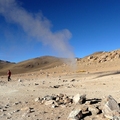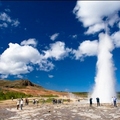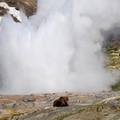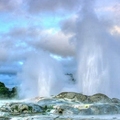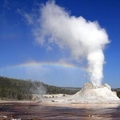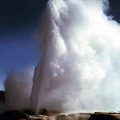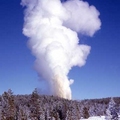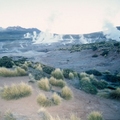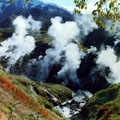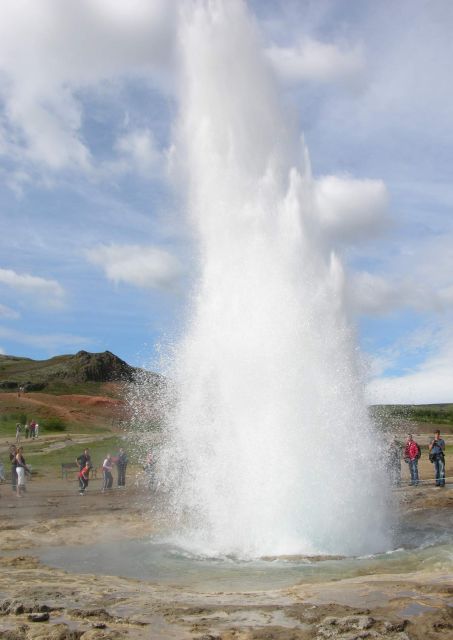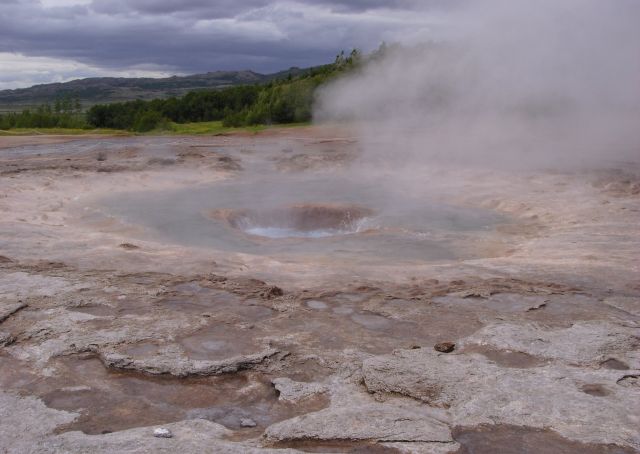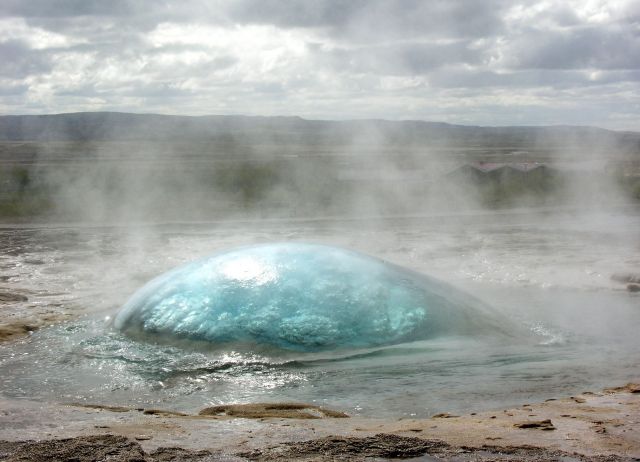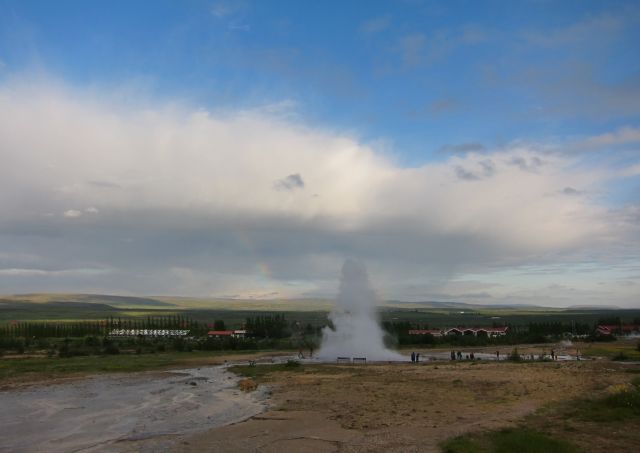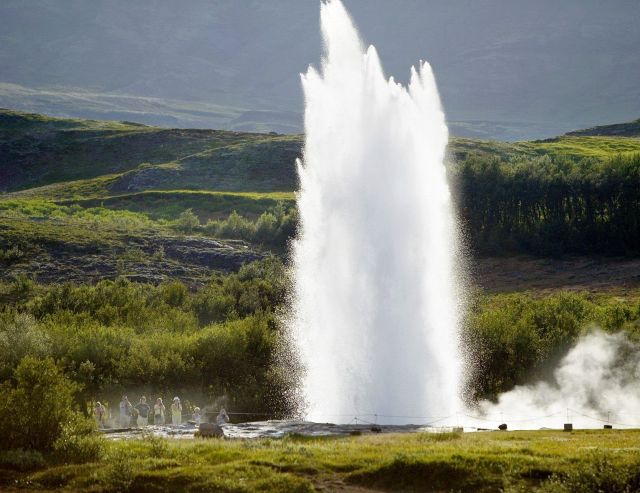World Tourism / The Most Impressive Geysers on the Earth / The Strokkur Geyser, Iceland
The Strokkur Geyser, Iceland
Description
Oohs and aahs raise from the clockwork. The turquoise water gurgles and bubbles from over the holes and it grows and grows until, with the pop and hiss, beats up, shooting to an impressive 30m high. Cue oohs and aahs.
The Geyser’s activity
Strokkur may not be the most impressive geyser in the world, but it is certainly the most reliable. It erupts as on a schedule, every five minutes or so. The name belonged to Iceland's most impressive geyser (pronounced gay-Zeer) - formidable geyser that shot 80 in the air, and provided the namesake for all other geysers around the world. Unfortunately for the Old Geyser, a group of tourists threw stones at him one day, trying to enhance it. Instead, the rock connected in the spring, and now it shoots up only sporadically, not having its original height. Same vandalism happened in the 1950s, other in the late 19th century. No matter when, the fact remains: Geysir lies silently ferry, while Strokkur has stepped in as the area's greatest attraction.
Striking area
Strokkur geyser is in the middle of the geothermal field, surrounded by Bubbling Springs and yellowed rocks, in the east of the Thingvellir National Park. This is an area of intense volcanic activity. The park is based on the fault of the Mid-Atlantic ridge line, where the European and the North American plates are literally pulling apart. This intense underground activity and pressure force the terrible Strokkur's explosions. Strokkur emits a fountain of hot water at a distance of 20 meters (70 feet) above the ground, and sometimes it even gives triple eruption, throwing out of the water column and a pair of three times in a row. Geysers are formed by a geothermal heat water that becomes trapped in narrow underground fissures. The water at the surface is cool, but the water below becomes hotter and hotter, warmed by the surrounding volcanic rocks, and it eventually turns to steam. After sufficient pressure is generated, steam blasts, firing up the surface water in a beautiful spray. The water there is stinky. All of Iceland from remote houses in rural areas to 5-star hotels in Reykjavik are heated with sulfuric natural sources of water, a smell with which the country quickly got used.
Strokkur-tourist attraction
Best time to visit the Strokkur geyser is from June to August, as the weather in Iceland has warm days at their longest and all tourist accommodations. Of course, this also means that when the country is busy. If you prefer a crowd, but still want a comfortable warm weather and long days, visit Strokkur in late May or early September. Just keep in mind that many hotels and restaurants in small towns operate only during the peak tourist season. Strokkur geyser is part of the Golden Circle - an area that includes a geyser, the Thingvellir park and the spectacular Gulfoss waterfall and it is a popular day trip from Reykjavik.
Give yourself a full day to take in all that the Golden Circle has to offer. Although you have to pay to get to Strokkur (either by bus, car or tour groups), it's free to view the geyser. Dress properly. The weather in Iceland is unpredictable and can vary from hot to cold, from sun to rain, within minutes. Do not stand downwind of the geyser Strokkur, if you're not in the mood for a shower.
Others from The Most Impressive Geysers on the Earth
Geysers are one of the manifestations of later stages of volcanism , and common areas of modern volcanic activity provided by hydrogeological conditions.
Being an intermittent hot water spring and vapor, volcanic, throwing water at regular intervals, to the sea lifting time form of a column, a geyser occurs if the activity of a volcano is at a late stage.
Large assets of geysers in the world are few , but they are of a rare beauty and fascination.
They are a pride and remarkable natural phenomena for the states where they are situated .
No matter what shape, cone-like or like fountains, geysers are rare as they need an almost perfect balance of heat and water conditions and the right rock and channeling.
Best spots of geysers in the world There are few best spots of geysers in the world.
There are only about a thousand geysers in the world situated on some major geothermal areas with geysers force on the Earth: Yellowstone Plateau in the U.
S.
A.
(where it is concentrated about half of all existing geysers), Iceland, New Zeeland( 58 geysers), Kamchatka, Chile, Papua New Guinea ( 38 active geysers), Indonesia( Sumatra Island – 17 geysers), Eastern Africa ( 6 geysers), China ( 10 geysers), Japan ( 4 geysers), Ethiopia and Kenya( very few).
Europeans first learned about the Icelandic geysers in the thirteenth century.
Yellowstone geysers were far from the civilized world until of the first decade of the nineteenth century.
John Colter ‘s stories were perceived as nonsense for too long time.
It took more than fifty years, unless specific expedition with the participation of artists and photographers convinced people of the existence of the world's largest geyser fields in the super-giant caldera of the dormant.
In 1872, Yellowstone geysers were under the protection of the world's first national park.
In 1850, a missionary from R.
Taylor became aware of the geysers in New Zealand.
It was only in 1941 that is only recently in historical terms, has been committed by one of the last great geographical discoveries on the planet.
Thegeologist T.
Ustinova and the conductor Alexander Krupenin, apparently, were the first humans to set foot on the shore of the river called Geyser.
What threatens the geysers? How long do they live? In some parts of the world geothermal geysers are simply former constructions.
In the 19th century , New Zealand North Island had five major geyser fields, which erupted about 220 geysers, now it has only 58 geysers, some of them quite small.
The reasons for the disappearance of New Zealand's geysers are different : natural disasters (volcanic eruption of Tarawera, changes on the groundwater levels), the drilling for the construction of thermal power plants, flooding during the construction of hydroelectric power.
The most powerful geyser on the Earth , Waimangu existed in New Zealand from 1899 to 1904.
With each eruption, it threw about 800 tons of water and trapped many jet stones raised by half a kilometer high.
There are even cases of death, found themselves too close to the erupting from the giant.
But Waimangu stopped working due to the lower water levels in the nearby lake.
Geysers are valuable destinations in the world.
A fascinating circuit where you can live unforgettable moments is visiting spectacular attractions such as the mysterious geysers.
They offer fascinating landscapes where majestic volcanoes and impressive lava formations are found together.
If you are a geyser fan, we offer a selection of the most beautiful and largest geysers in the world.

